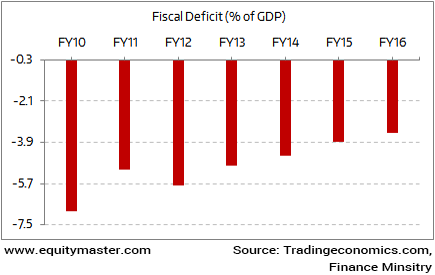- Home
- Todays Market
- Indian Stock Market News December 26, 2017
Indian Indices Trade Marginally Lower; Banking Stocks Witness Losses Tue, 26 Dec 11:30 am
After opening the day marginally higher, share markets in India witnessed volatile trades and are presently trading marginally lower. Sectoral indices are trading on a mixed note with stocks in the telecom sector and banking sector witnessing maximum selling pressure. Stocks from the realty sector are trading in the green.
The BSE Sensex is trading down 11 points (down 0.03%) and the NSE Nifty is trading down by 2 points (down 0.02%). The BSE Mid Cap index is trading up by 0.5%, while the BSE Small Cap index is trading up by 0.7%. The rupee is trading at 64.06 to the US$.
In the news from the macroeconomic front, as per an article in the Economic Times, many sections of the economy believe that the government should not cut its spending on key programmes in order to meet the fiscal deficit target this year.
The reason supporting this view is that fiscal slippage, if any, is likely to be from the revenue side because of the disruption caused by GST and not from the spending side.
The above view comes as the government aims to meet its long term fiscal deficit target of 3% by FY17-18.
The government has budgeted spending of Rs 21.5 trillion in FY18. Of this, it had spent Rs 12.9 trillion by October with a fiscal deficit of Rs 5.25 trillion against a full-year fiscal deficit budget of Rs 5.47 trillion. And this has led to fiscal slippage concerns this year.
One must also note that in the last one decade, India is making serious efforts to reduce the fiscal deficit level. Ever since, the new government came in it has been in favor of fiscal consolidation and meet the long term fiscal deficit target of 3% by FY17-18. This will be the lowest target compared to the last couple of years, as can be seen from the chart below:
Fiscal Deficit target of 3% of GDP
That said, challenges remain. The notebandi exercise has resulted in a slowdown. Further, government has announced flurry of projects but execution is still pending. This means the government needs to relax its spending to spurt the growth again.
This means, once again, the government needs to fight dual challenge. First, maintaining its stance on fiscal consolidation and sticking it fiscal deficit target of 3% of GDP for FY17-18. Second, it must relax the deficit target for reviving the economic growth from the shock of demonetisation.
It is also worthwhile to note that creating economic growth by the government spending its way out of trouble, cannot continue indefinitely.
As Vivek Kaul writes in one of his recent editions of the Vivek Kaul's Diary... 'At the end of the day the government has a limited amount of money at its disposal. Further, its expenditure tends to be terribly leaky and does not reach a major portion of those it is intended for.'
It would be interesting to see how the government tackle the above challenges. We'll keep you updated on the developments from this space.
In the news from commodity space, crude oil has continued its momentum and is witnessing buying interest today.
It is trading near its June 2015 levels on the back of an outlook for healthy demand amid ongoing production cuts led by OPEC and Russia.
Note that crude oil prices have been on a rising trend this year. However, this is not good news from India's perspective.
As we wrote in a recent edition of The 5 Minute WrapUp...
- Fiscal revenues are at risk. Particularly if the government is forced to consider a cut in fuel excise duties due to a rally in oil prices. In recent times, a sharp jump in excise collections has helped indirect tax collections. Any risk to revenues and subsequent threat to the fiscal deficit target at 3.2% of GDP would require tighter spending cuts.
Secondly, the impact on inflation needs to be monitored. This narrowing the central bank's scope for further rate cuts.
Lastly, low crude prices were a positive growth impetus through higher discretionary incomes for households and lower input costs for manufacturers and farmers. Part of this benefit is likely to be eroded as retail fuel costs rise. As for corporations, expansion in gross margins caused by falling commodity prices is also likely to wane, pressurising profitability.
You can read the entire article here.
To keep a tab on the movements in crude oil and other commodities, you can read the stock market commentary from the Daily Profit Hunter team. Their commentary tracks the developments in the global economy as well as stock, currency, and commodity markets.
For information on how to pick stocks that have the potential to deliver big returns, download our special report now!
Read the latest Market Commentary



Equitymaster requests your view! Post a comment on "Indian Indices Trade Marginally Lower; Banking Stocks Witness Losses". Click here!
Comments are moderated by Equitymaster, in accordance with the Terms of Use, and may not appear
on this article until they have been reviewed and deemed appropriate for posting.
In the meantime, you may want to share this article with your friends!